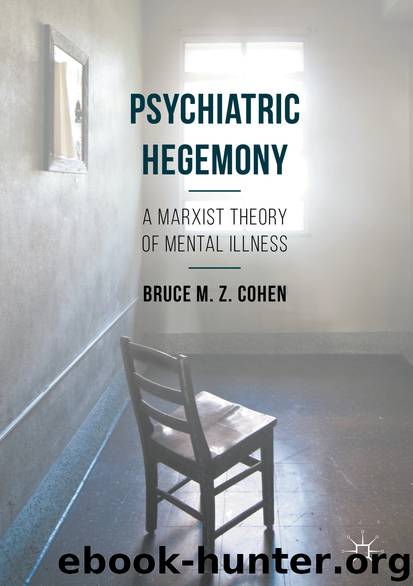Psychiatric Hegemony by Bruce M. Z. Cohen

Author:Bruce M. Z. Cohen
Language: eng
Format: epub
Publisher: Palgrave Macmillan UK, London
Scull, A. (1993) The Most Solitary of Afflictions: Madness and Society in Britain, 1700–1900. New Haven: Yale University Press.
Zimbardo, P. G. (1977) Shyness: What It is, What To Do About It. Reading, MA: Addison-Wesley.
© The Author(s) 2016
Bruce M. Z. CohenPsychiatric Hegemony10.1057/978-1-137-46051-6_5
5. Youth: Medicalising Deviance
Bruce M. Z. Cohen1
(1)Department of Sociology, University of Auckland, Auckland, New Zealand
This chapter considers the key economic and ideological factors within capitalist society that have precipitated what might be described as the relatively recent psychiatric and therapeutic “gold rush” of diagnosing young people with ever greater varieties of mental illness. As regimes of work have changed throughout the twentieth century and the demand for the workforce to possess higher and more complex skills has become greater, it will be shown that a focus on compulsory schooling justifies the closer surveillance and control of youth behaviour by psychiatric and associated professions. In forwarding the central argument of this book, a socio-historical analysis is performed on the diagnosis of ADHD, currently the most popular mental illness label given to school-aged children and young adults. While considering the issues of deinstitutionalisation, psy-professional struggles over jurisdiction, and the encroaching power of the pharmaceutical industry, the ADHD case study, along with textual analyses of consecutive DSMs, will show that the increasing infiltration of the psychiatric discourse into the education system serves a significant function for capitalism in enforcing dominant moral codes and economic prerogatives while pathologising any deviation or resistance to these patterns of authority.
Wilkinson and Pickett (2010: 63) estimate that a million children in Britain are currently mentally ill, including one in ten of those aged between five and sixteen. Understanding these figures in the context of the education system, the scholars note that “in any secondary school with 1000 students, 50 will be severely depressed, 100 will be distressed, 10–20 will be suffering from obsessive-compulsive disorder and between 5–10 girls will have an eating disorder” (Wilkinson and Pickett 2010: 63). And the numbers appear to be growing. For example, in the case of attention-deficit/hyperactivity disorder (ADHD), three to five per cent of young people in the US were diagnosed with the disorder in 1970s (Conrad 2006: xi) whereas the current estimate is between seven and nine per cent of the youth population (Bowden 2014: 423). Recent studies from the US Centers for Disease Control and Prevention suggests an even higher rate of 11 per cent of school-age children, including 20 per cent of the male population (Saul 2014: 16). This represents a growth in ADHD in the US of 41 per cent in the last ten years (Saul 2014: 16). Whitaker and Cosgrove (2015: 92) estimate that 3.5 million young people in America are now being prescribed ADHD medication, which is “nearly six times the number in 1990.”
As will be detailed later in this chapter, my analysis suggests that the range of mental disorders that can be associated with young people is currently 47 from a total of 374 classified in the DSM-5. Fifty years ago, in the first edition of the DSM, the figure was just eight.
Download
This site does not store any files on its server. We only index and link to content provided by other sites. Please contact the content providers to delete copyright contents if any and email us, we'll remove relevant links or contents immediately.
| Administration & Medicine Economics | Allied Health Professions |
| Basic Sciences | Dentistry |
| History | Medical Informatics |
| Medicine | Nursing |
| Pharmacology | Psychology |
| Research | Veterinary Medicine |
Periodization Training for Sports by Tudor Bompa(7916)
Why We Sleep: Unlocking the Power of Sleep and Dreams by Matthew Walker(6352)
Paper Towns by Green John(4790)
The Immortal Life of Henrietta Lacks by Rebecca Skloot(4253)
The Sports Rules Book by Human Kinetics(4077)
Dynamic Alignment Through Imagery by Eric Franklin(3919)
ACSM's Complete Guide to Fitness & Health by ACSM(3823)
Kaplan MCAT Organic Chemistry Review: Created for MCAT 2015 (Kaplan Test Prep) by Kaplan(3800)
Introduction to Kinesiology by Shirl J. Hoffman(3626)
Livewired by David Eagleman(3534)
The River of Consciousness by Oliver Sacks(3417)
The Death of the Heart by Elizabeth Bowen(3336)
Alchemy and Alchemists by C. J. S. Thompson(3294)
Descartes' Error by Antonio Damasio(3164)
Bad Pharma by Ben Goldacre(3095)
The Emperor of All Maladies: A Biography of Cancer by Siddhartha Mukherjee(2928)
The Gene: An Intimate History by Siddhartha Mukherjee(2927)
The Fate of Rome: Climate, Disease, and the End of an Empire (The Princeton History of the Ancient World) by Kyle Harper(2870)
Kaplan MCAT Behavioral Sciences Review: Created for MCAT 2015 (Kaplan Test Prep) by Kaplan(2815)
